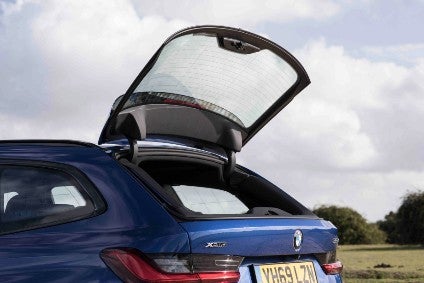
Eighteen months in since production of the latest 3 Series commenced, BMW continues to tweak its best selling car via additional engines and updates for the operating system. With the addition of the G21 estate to the G20 and China’s G28 extended wheelbase Li sedans, the range of body styles is also now complete.
The new Touring has some big shoes the fill, BMW having sold more than 500,000 units of the prior generation and 1.7 million in total since the first edition arrived in 1987. The estate body style is key to 3 Series sales in many of Europe’s larger markets, Germany being the obvious one, but G21 is also an important car for BMW UK.
Just before production of the newly arrived Touring and year-old sedan had to be stopped at the main plant in Munich back in Q1, BMW was about to start producing a new 2.0-litre diesel for both cars. That engine, which is now being fitted to model year 2020 cars, features a 48 V mild hybrid system and is boosted by an 8 kW (11 hp) starter generator.
This was my first experience with G21, the estate having been added to the line-up late last year. Dimensions are up: by 76 mm to 4,709 mm in length, by 16 mm to 1,827 mm for width and by 11 mm to 1,440 mm in height. There’s also a longer wheelbase (by 41 mm), this now being 2,851 mm. Those four centimetres make all the difference to back seat leg room, something the old Touring wasn’t great for.
The car is immediately familiar yet fresh at the same time even though every panel is new and the roofline is lengthier. Along with a stainless steel load sill cover, roof rails are part of the standard specification for all versions and come in either Black Matte (SE model grade) or Black High-gloss Shadow Line (Sport, M Sport and M Sport Plus Edition).
BMW says there is an extra 112 mm of width in the boot, with a 300 mm higher loading aperture while the step between the boot floor and the sill has been reduced in height from 35mm to 8mm – good news for when you need to load bulky or heavy cargo. There is also a handy new option in the form of anti-slip, rubberised rails. Integrated with the floor of the load bay, these extend automatically when the tailgate is shut, preventing things sliding around. As soon as the driver switches off the engine, the rails then return to their stowed position. The boot’s capacity is up by five litres to an even 500.

US Tariffs are shifting - will you react or anticipate?
Don’t let policy changes catch you off guard. Stay proactive with real-time data and expert analysis.
By GlobalDataA new standard feature for the 3 Series Sedan and Touring from this summer, Operating System 7 was previously only used in conjunction with BMW Live Cockpit Professional. The latest update sees what BMW terms “extensive individualisation and personalisation” of the content shown on the Control Display. As part of the upgrade, the Live Cockpit display gains a redesigned instrument cluster with a 5.1-inch digital display at its centre. Live Cockpit Plus, as with Live Cockpit Professional, also includes BMW’s Intelligent Personal Assistant (i.e. “Hey, BMW” voice commands).
BMW has fitted all 3 Series Tourings with new front seats, addressing another criticism which some levelled as the old model. While that firmness never bothered me, these latest ones are wonderfully snug. The test vehicle had sports seats, incidentally, standard on Sport and M Sport cars.
Unusually for a BMW, the 320d’s badge accurately denotes the engine’s capacity (1,995 cc). Power is 140 kW (190 hp) with 400 Nm of torque, drive going to both axles via an eight-speed automatic transmission. You don’t have to have the xDrive system though as there are rear-wheel drive versions of the 320d Saloon and Touring.
As well as a better CO2 average (112-109 g/km versus 119-117) the RWD cars are slightly faster than the xDrive sedan and Touring (0-62 mph in 7.1 seconds and a 230 km/h top speed as opposed to 7.4 and 225). Official Combined fuel consumption is even more impressive, at just over 65 mpg and even under normal driving conditions owners will see better than 55 mpg. The new 2.0-litre diesel is also already euro 6d compliant.
The new engine and its mild hybrid drive are aided by a number of other factors in the achievement of those first rate fuel consumption and CO2 numbers. The list includes low rolling resistance tyres, a coasting mode for the transmission, an optimum shift indicator, active air flaps in the grille as well as the stop-start and braking energy regeneration systems. Other bits of wizardry are on-demand activation of various ancillaries, a map-regulated oil pump and optimised warm-up for the differential.
The all-wheel drive system might add weight and push up the CO2 average but it’s worth it and that’s just from experience in summer driving. You really can convince yourself that this is more of a sports car rather than the practical estate that the sensible side of your brain says it is.
Is the 3 Series Touring still the best in its class? For keen drivers, the 320d in M Sport form takes some beating, much of that being thanks to the fantastic torque curve and the beautifully balanced chassis.
The BMW 320d Touring xDrive costs from GBP40,210 before options.



